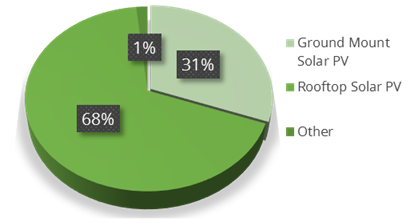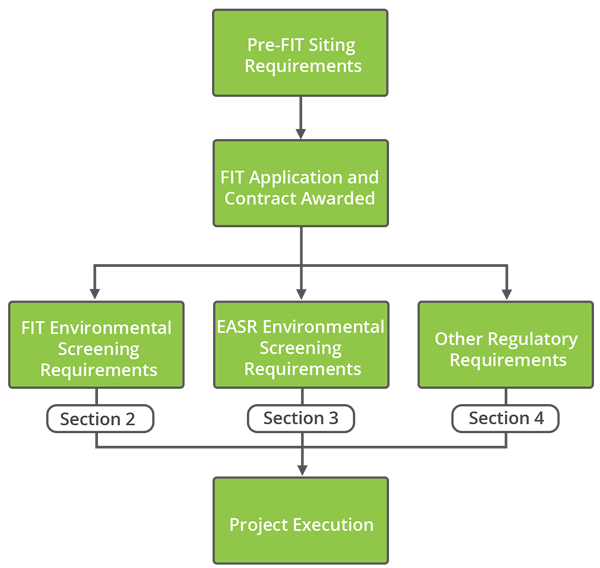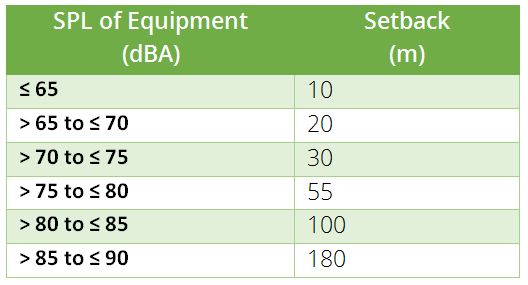This paper will identify and explain the environmental concerns and siting requirements for small ground mount solar PV projects within the FIT 3 and EASR frameworks, discuss the discrepancies, interpretations, and provide a path forward towards successful project execution.
Environmental Concerns and Siting Requirements for Small Ground Mount Solar Projects
Contributed by | Endura Energy, a UGE Company
1 Introduction
In July and December, 2014, the Ontario Power Authority (now the Independent Electricity System Operator, IESO) issued 224 MW of Feed in Tariff (FIT) 3 contracts for electricity generated using renewable fuels, 69 MW of which were for small (≤ 500 kW) ground mount solar generation (Figure 1).

Figure 1: Capacity of offered FIT 3 contracts by fuel type; this paper is essential reading for Ground Mount Solar PV contract holders
Small ground mount solar projects for FIT 3 and previous FIT allocations, much like utility scale solar projects (> 500 kW), are subject to strict environmental, archaeological, and cultural siting requirements, enabled by the Green Energy Act, 2009 (GEA). Since the inception of the GEA, obtaining the necessary permits and approvals for all ground mount solar PV projects has been very expensive. Projects were required to comply with Ontario Regulation 359/09 (O. Reg. 359/09) of the Environmental Protection Act (EPA, 1990) and obtain a Renewable Energy Approval (REA). To alleviate the expensive and cumbersome process for small ground mount solar PV, the Ontario Ministry of the Environment (MOE) introduced in 2012 the Small Ground Mounted Solar Facilities category into the Environmental Activity and Sector Registry (EASR) under Ontario Regulation 245/11 and 350/12 of the EPA.
The EASR is intended for activities or sectors that:
- Pose minimal risk to the environment and human health when regulated and following specific rules
- Use equipment and processes that are standard to the industry or sector with known environmental impacts
The EASR stipulates specific regulations for an activity; applicants who self-register for the EASR are required to follow its rules but are not required to follow the typical process of such activities in accordance with the REA requirements of under the EPA.
The IESO enforces environmental screening criteria through the FIT rules (Sect. 2); the MOE enforces these through the EASR (Sect. 3). However, lack of consultation between the IESO and MOE leads to varying definitions for common terms and conflicting limits for the same criteria. Both the FIT rules and EASR lack clarity, and experience is required to avoid misinterpretation (Sect. 4).
While the EASR is designed to streamline the application process by amalgamating environmental screening requirements into a single process, only those requirements fulfilled by an REA are replaced by the EASR; compliance with all other government ministries and legislation is still required, and is the responsibility of the project developer (Sect. 4).
The additional screening and permitting requirements should be considered in parallel with the FIT and EASR requirements. They can require a significant amount of lead time and treating them as an afterthought has previously delayed projects. Figure 2 outlines the recommended permitting and approvals process for a ground mount solar PV project, and where to find information herein.
This paper will identify and explain the environmental concerns and siting requirements for small ground mount solar PV projects within the FIT 3 and EASR frameworks, discuss the discrepancies, interpretations, and provide a path forward towards successful project execution.

Figure 2: Flowchart of environmental screening requirements
2 FIT Requirements
The FIT program protects prime agricultural areas in Ontario though the Ontario Ministry of Food, Agriculture and Rural Affairs (OMAFRA) Canada Land Inventory (CLI) system. CLI maps identify soil quality throughout Ontario as prime or non-prime agricultural. Projects to be located on properties comprised of both prime and non-prime agricultural land require soil studies to determine allowable siting locations.
Significant exclusions to these regulations exist for projects located on First Nations lands. Further restrictions apply to projects located in areas designated as Specialty Crop Areas.
2.2 Zoning and Visual Screening
The FIT program places restrictions on projects located on or adjacent to lands zoned to permit residential use; in many cases this includes agricultural properties that qualify for the EASR. The FIT requirements stipulate Visual Screening Requirements for any project located on a property that abuts an opened road allowance or land zoned residential or rural-residential. The extent of these requirements varies based on specific project geometry and is subject to interpretation of the FIT requirements.
2.3 Physical Setbacks
Any project located in whole or in part on Rural-Residential lands is intended to comply with the Setback Requirements. For most properties, this means that all Generating Equipment, including transformers and inverters, must be at least 20 m from any External Boundary.
3 EASR Requirements
Only non-rooftop solar PV facility of a certain size are eligible for this category of the EASR; the facility must have a nameplate alternating current (AC) capacity of greater than 10 kW and not more than 500 kW, and transformers of nameplate capacity no greater than 750 kVA. Certain areas, such as the Lake Simcoe watershed and the Niagara Escarpment Planning Area, require special consideration.
3.2 Zoning
The zoning classification of the property determines the maximum allowable size of a facility to be filed under the EASR. For a facility located on land used for farming activities and which is not a settlement area the facility size must not exceed three hectares. If the facility is located on land zoned as industrial, commercial, or institutional and the land is either used as such or considered contaminated, the facility can be up to four hectares in size.
3.3 Physical Setbacks
The distance between any solar panel and the property boundary must be no less than 15 metres in order that a facility qualify for the EASR.

3.4 Noise
Qualification for the EASR falls within very specific requirements related to the emission of noise. No piece of equipment may have a sound power level (SPL) in excess of 90 A-weighted decibels (dBA). Noise generating equipment must be located a certain minimum distance from the property boundary according to the sound power level of the equipment, with louder equipment requiring a larger setback. However, in the event that the SPL at the property boundary (including facility noise) is less than 40 dBA or less than the lowest hourly ambient SPL at the property boundary (in the absence of the facility) then the setback requirements are not applicable (to be verified through Noise Impact Study). Noise mitigation options are available for prohibitively loud equipment.

3.5 Natural and Cultural Heritage
3.5.1 Water Body
Facilities are ineligible for EASR if they are within 30 metres of a water body. A water body includes lakes, kettle and Lake Trout lakes, permanent and intermittent streams, and seepage areas, subject to a number of exclusions. Projects located within the Lake Simcoe watershed are subject to unique considerations.
3.5.2 Archaeological Site or Management Area
In order to preserve cultural heritage and evidence of past human activity, any site located within 250 metres of an archaeological site or within an area identified as being of archaeological potential does not qualify for the EASR. An archaeological site is any property that contains evidence of past human activity that is of cultural heritage significance. The Ontario Ministry of Tourism, Culture and Sport (MTCS) maintains records of archaeological sites. Local and upper-tier municipalities define areas of potential archeological interest or sensitivity and quantify them in archaeological management plans.
3.5.3 National Historical Site
The presence of a national historic site, as commemorated by the Historic Sites and Monuments Act, excludes a facility located on the same property from qualifying for the EASR. National historic site can be identified by Parks Canada, the MTCS, and/or individual municipalities.
3.5.4 Niagara Escarpment Planning Area
Any facility within the Niagara Escarpment Planning Area must comply with any development permitting requirements of the Niagara Escarpment Planning and Development Act, and those requirements must not conflict with the requirements of the EASR.
4 Discussion
4.1 Clarity of FIT Requirements
4.1.1 Wording of Zoning Requirements
Section 2.3 of the FIT rules details Non-Rooftop Solar Project Specific Eligibility Requirements; subsections (e) through (h) refer to zoning. In brief, Subsections (e) and (f) state that projects cannot be on or adjacent to a property where someone can live, and subsection (g) says that you can ignore (e) and (f) if you are not in an urban centre and agree to comply with the Visual Screening and Setback requirements.
The fifteen lines outlining rural-residential zoning requirements in the FIT rules include no less than twelve “negative” words (not, but, if, etc). The clauses stipulate what is not allowed, and then discuss exceptions to the rules, making them wordy and difficult to follow.
4.1.2 External Boundary
The FIT documentation leaves certain areas open to interpretation, and it is possible to follow the “letter of the law” while disregarding the obvious intention of the documents. In particular, both the Visual Screening Requirements and Setback Requirements rely on the following definition of an External Boundary:
External Boundary means, in respect of a Site located on more than one Property, a Boundary or portion of a Boundary that is not a Boundary between one Property on which such Site is located and another Property on which such Site is also located.”
- FIT 3 Appendix 1–Standard Definitions
Since the definition of External Boundary applies only to a Site located on more than one Property, and the Setback and Visual Screening Requirements are defined in terms of External Boundaries, it can be interpreted that the Setback Requirements and, when abutting a residential property, the Visual Screening Requirements, do not apply to a Site located on a single property. While this is clearly not the intention of the rule, it may be in compliance with the specific wording.
4.2 Clarity of EASR
The function of the EASR is to roll a number of requirements into one streamlined process. It is unclear in a number of cases what is encompassed by the EASR, and what is still required. The EASR User Guide states that,
“Applying for [an REA] may involve the submission of various forms, design reports and studies, among other documents, to the Ministry. … [If] activities related to a facility are prescribed in regulation for the purposes of the EASR (e.g. an eligible solar facility), then [an REA] is not required.”
This implies that registration in the EASR is all encompassing, and that no other forms, reports or documents are required. However, this could not be more incorrect, as,
“There is a range of additional provincial and federal agencies that may require specific permits during the construction, operation or decommissioning of a solar facility that are not explicitly prescribed in the EASR, such as … [the] Ontario Heritage Act”
It would be easy to think that compliance with the EASR “Eligibility Criteria related to Natural and Cultural Heritage” encompassed compliance with the Ontario Heritage Act. This is only one example of the lack of clarity surrounding what is covered under the EASR and what is not.
The EASR User Guide refers applicants to the Technical Guide to Renewable Energy Approvals for a list of additional permits that may be required. However, the list provided in this guide disclaims completeness and places the onus of responsibility on applicants for determining all requirements. It also adds, almost as an afterthought, that the Federal Government may have requirements, too.
Determining what requirements the EASR alleviates and what requirements still apply is a distinction best learned through experience.
4.3 Discrepancy Between FIT and EASR
It would be natural to assume that the IESO and the MOE – the two bodies who govern siting of small ground mount PV projects – would have collaborated on the requirements of the EASR. This does not appear to be the case, and has led to discrepancies between the criteria stipulated by each body.
4.3.1 Zoning
The FIT and EASR definitions of eligibly zoned properties are not identical, and do not overlap in all cases. Most ground mount FIT projects are sited on Rural-Residential Lands, on which residential use and at least one other use constitute the primary eligible uses of the land. The EASR stipulates that the facility can be located on land used for farming activities, and lists eligible activities as growing crops, raising animals, and processing such. Developers should be wary that satisfying one requirements does not guarantee compliance with the other.
4.3.2 Multiple Properties
The FIT documentation contains specific rules for facilities that span multiple adjacent properties. This can be complicated or relatively straightforward, depending largely on the zoning of each property. Conversely, a facility located on more than one property is not eligible for the EASR (0.Reg. 350/12, s.3 (8) 3). A project spanning multiple properties may seem feasible from a FIT perspective, only to encounter an economic roadblock as an REA would be required.

4.3.3 Setback Requirements
The EASR stipulates that solar PV panels must be setback 15 metres from the property boundary, while the FIT regulations dictate 20 metres for not just panels but all Generating Equipment and transformers and inverters.
The definition of an “External Boundary” given in the FIT Standard Definitions is poorly written. If interpreted as intended, the FIT Contract stipulates a stricter setback requirement than the EASR. If interpreted as written, the FIT Contract setback requirements from External Boundaries only apply to projects that span multiple adjacent properties.
4.4 Species at Risk / Endangered Species
The Endangered Species Act, 2007 (ESA) identifies species at risk in Ontario and imposes strict restrictions on the destruction or disruption of endangered species including their habitat. Of particular concern in Ontario are the bobolink (Dolichonyx oryzivorus), the eastern meadowlark (Sturnella magna), endangered bat species’ roosting areas (trees), among many reptilian species.
4.5 Other Approvals and Requirements
Applicants under the EASR are still responsible to/under a number of other Ministries, Acts, and organizations for siting requirements. These include:
- Ministry of Natural Resources (Endangered Species, Fish and Wildlife Conservation Act)
- Conservation Authorities Act
- Transportation Act
- Ontario Water Resources Act
- Clean Water Act
- Oil, Gas and Salt Act
- Local Municipalities (Drainage Act, Lake Simcoe Area, Niagara Escarpment Area)
- Federal Government
5 Conclusion
While the EASR does alleviate the need for an REA for most small ground mount solar projects, the environmental screening and permitting process is still extensive. In many instances, the FIT and EASR regulations are poorly written, and sections are open to interpretation and require experience to navigate correctly or advice from legal counsel. It is important to consider both the FIT and the EASR, since a project satisfying the requirements of one can still be in noncompliance with the other. Thorough knowledge of and past experience with both frameworks can be the difference between smooth, successful project execution and a path barred by red tape.
Many other government bodies hold jurisdiction over environmental aspects of small ground mount solar PV projects, such as the MNR, local municipalities, and the federal government. There is no comprehensive list of all environmental and permitting requirements for a project, but the project developer is responsible for ensuring that all requirements are met. Experience is necessary to know what is important and what is required.
The additional permits required for project approval can take weeks or months to acquire, as government bodies receive and review applications and documents. These requirements should be considered in parallel with the FIT and EASR approval processes (Figure 2). Compared to other development costs, these permits are very affordable. It is wiser to begin the process of acquiring additional permits early, and risk those costs being forfeit, rather than starting the process too late and bypassing a critical path item or date, or having a fully constructed project that cannot be connected to the grid (this has occurred).
Endura Energy has developed, designed, or constructed over 220 MW of FIT projects to date, and is currently involved with approximately 20MW of FIT 3 projects. We have developed and constructed projects based on our interpretation of the FIT documents, successfully registered ground mount solar PV facilities in the EASR, and identified, applied for, and received the required additional permits and approvals on a project by project basis.
Consulting with Endura in the early development stages of your project will help ensure a more diligent and lower risk approach for execution of a successful project or portfolio.
Please contact Robert van Duynhoven to discuss your project robert.vanduynhoven@ugei.com.
The content & opinions in this article are the author’s and do not necessarily represent the views of AltEnergyMag
Comments (0)
This post does not have any comments. Be the first to leave a comment below.
Featured Product

